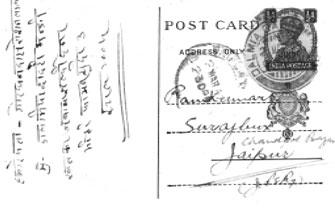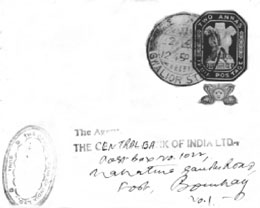Merger of Postal System
By:
Mr. Ashok Kumar Bayanwala
Though the Princely States merged with Indian Union as per dates described above, all post offices of such Feudatory States except Anchal Offices of Travancore and Cochin State, merged with Indian Posts and Telegraphs Department from 1st April 1950. The validity of such States’ stamps remained till 30th April 1950. And after such date the stamps and postal stationery could be exchanged with current issues of India at any ex-State post office, till 31st July 1950.
 |
The take over of post offices of Conventional States which were
using overprinted Indian stamps, was a bit different and was as follows:
![]() The Postal System of Chamba State
was taken over by Indian Posts & Telegraphs Department with effect from
1st August 1949, vide Postal Notice No.40 dated 7th November 1949. Overprinted
postage stamps will no longer be sold from Chamba post offices, but articles
bearing overprinted stamps would not be taxed upto 30th November 1949.
The Postal System of Chamba State
was taken over by Indian Posts & Telegraphs Department with effect from
1st August 1949, vide Postal Notice No.40 dated 7th November 1949. Overprinted
postage stamps will no longer be sold from Chamba post offices, but articles
bearing overprinted stamps would not be taxed upto 30th November 1949.
![]() The Postal system of Patiala, Nabha
and Jind States were taken over by the Indian Post & Telegraphs Department
with effect from 16th September 1949 vide DGPO Circular No.49 dated 28th November
1949. Articles bearing overprinted stamps would not be taxed till 31st October
1949. The validity of these overprinted stamps of these Conventional States
namely Patiala, Nabha and Jind was extended till 30th April 1950.
The Postal system of Patiala, Nabha
and Jind States were taken over by the Indian Post & Telegraphs Department
with effect from 16th September 1949 vide DGPO Circular No.49 dated 28th November
1949. Articles bearing overprinted stamps would not be taxed till 31st October
1949. The validity of these overprinted stamps of these Conventional States
namely Patiala, Nabha and Jind was extended till 30th April 1950.
 |
 |
|
A 9 Pies Post Card of KGVI was overprinted as “NABHA”
- Conventional State and it was posted to Jaipur from Jaitu Post Office
on 22nd July 1949.
|
½ Anna Post Card of KGVI was overprinted as “JIND” - Conventional state and it was posted on 2nd March 1949 |
![]() And the Postal System
of the remaining Conventional State of Gwalior was merged with the Indian
Post & Telegraphs Department on and from 1st April 1950 vide DGPO circular
No.69 dated 27th March 1950. The validity of overprinted stamps of Gwalior
was fixed as per other Conventional State i.e. 30th April 1950. After such
date these overprinted stamps could not be used but exchanged with current
Indian stamps till 31st July 1950.
And the Postal System
of the remaining Conventional State of Gwalior was merged with the Indian
Post & Telegraphs Department on and from 1st April 1950 vide DGPO circular
No.69 dated 27th March 1950. The validity of overprinted stamps of Gwalior
was fixed as per other Conventional State i.e. 30th April 1950. After such
date these overprinted stamps could not be used but exchanged with current
Indian stamps till 31st July 1950.
 |
 |
|
½ Anna Post Card with 3 Pies stamp - both overprinted
and used on 30th June 1949 after the increase in Post Card rate from
½ Anna to 9 Pies on 1st April 1949.
|
Till 31st March 1949, Gwalior State Post Office which used overprinted stamps of British India. From 15th August 1947 to 31st March 1950, its status remained unchanged, therefore it used Independent India 2 Annas Postal Stationery overprinted “Gwalior”. |
These dates were again extended vide Postal Notice No.20 dated 26th June 1950. The validity of these overprinted stamps was extended till 31st December 1950 and the date for exchange was extended till 31st March 1951. It can exchanged at any ex-State Post Offices. Where ex-State P.O. had been closed down then any Post Office of that town or village was empowered to exchange such stamps and postal stationery. A question had been raised as to whether ex-State postal stationery on which an individual or firm had its name, address etc., printed, but which had not been actually postal used, may be allowed to be exchanged for Indian stamps. If such postal stationery had not been actually used, may be allowed to be exchanged, vide DGPO Circular No.23 dated 26th June 1950. Thus the integration of States Postal System (except Travancore and Cochin State) with the Indian Posts and Telegraphs Department was complete.
![]() The Anchal Offices
of Travancore and Cochin State did not become integral part of the Indian
P & T Department on 1st
The Anchal Offices
of Travancore and Cochin State did not become integral part of the Indian
P & T Department on 1st  April
1950. The special postage rates and fees which would apply to the internal
service of the State would be notified by the PMG Madras. These special postage
rates would be valid only within the State. If postal articles were sent outside
the T & C State, the rates and conditions of the Indian P & T Department
would apply. The Anchal postage stamps and postal stationery would be accepted
in payment of postage for articles posted at Anchal office deliverable within
the State. It means that Anchal stamps and stationery could not be used for
correspondence deliverable outside the State, or otherwise such articles would
be treated as unpaid, vide DGPO Circular No.69 dated 27th March 1950.
April
1950. The special postage rates and fees which would apply to the internal
service of the State would be notified by the PMG Madras. These special postage
rates would be valid only within the State. If postal articles were sent outside
the T & C State, the rates and conditions of the Indian P & T Department
would apply. The Anchal postage stamps and postal stationery would be accepted
in payment of postage for articles posted at Anchal office deliverable within
the State. It means that Anchal stamps and stationery could not be used for
correspondence deliverable outside the State, or otherwise such articles would
be treated as unpaid, vide DGPO Circular No.69 dated 27th March 1950.
Anchal stamps and postal stationery became valid even outside
the State of Travancore and Cochin, vide DGPO Circular No.18 dated 5th June
1950.
DGPO Circular No.48 dated 30th September 1950 reads as follows:
“It is hereby notified for the information of all concerned that “Anchal”
service articles, that is, official postal articles pertaining to the business
of the “Anchal” system (i.e. ex-State Postal System) in the Travancore
- Cochin State posted by Anchal (Postal) Officers & Postmasters, etc.,
should be given free transmission through the post within and outside the
Travancore - Cochin State, in the same manner as P & T Service articles
bearing the inscription “Indian Post and Telegraphs Department”.
Such articles should on no account be taxed. Unless it is found that they
do not relate to the official business of the Anchal System and are not posted
by persons authorized in this behalf”.
On 1st April 1951 Anchal offices of Travancore - Cochin State merged with
Indian Postal System, vide DGPO Circular No.90 dated 31st March 1951. The
DGPO Circular No.1 dated 5th April 1951 clarifies as follows:
“With effect from 1st April 1951, the Anchal or Local Postal System,
in Travancore - Cochin State will be directly administered by the Central
Government and the “Agency” system by which the State Government
managed the system from the 1st April 1950, will cease”.
Anchal postage stamps and printed postal stationery would cease to be valid
for prepayment of postage with effect from the 1st July 1951, vide DGPO Circular
No.10 dated 9th May 1951. Till then, they should continue to be recognized
as valid on postal articles destined for places both inside and outside the
Travancore - Cochin State. And after 30th June 1951, these Anchal stamps could
be exchanged for India postage stamps till 30th September 1951.
BIBLIOGRAPHY: 1. White Paper on Indian States. 2. Integration of the Indian States by Mr.V. P. Menon. 3. Postal Notices and Circulars.
Readers are requested to send their query/comments to Mr. Ashok Kumar Bayanwala, 96, Swastik Society,Navarangpura, AHMEDABAD-380009, INDIA or email to Prashant H. Pandya